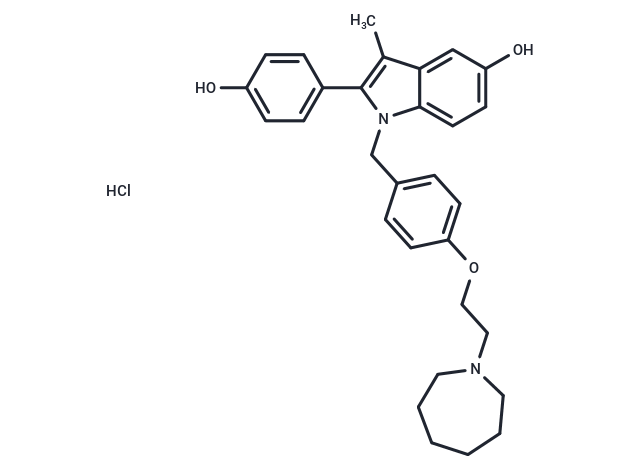Shopping Cart
- Remove All
 Your shopping cart is currently empty
Your shopping cart is currently empty

Bazedoxifene hydrochloride (TSE 424 hydrochloride) is an orally active, selective, and potent estrogen receptor modulator (SERM) that crosses the blood-brain barrier and is an inhibitor of IL-6/GP130 protein interactions with high affinity for ERα and ERβ. It has a high affinity for ERα and ERβ and can be used to study postmenopausal osteoporosis and vasodilator-related diseases.

| Pack Size | Price | Availability | Quantity |
|---|---|---|---|
| 1 mg | $55 | In Stock | |
| 5 mg | $140 | In Stock | |
| 10 mg | $252 | In Stock | |
| 25 mg | $393 | In Stock | |
| 50 mg | $709 | In Stock | |
| 100 mg | $987 | In Stock | |
| 500 mg | $1,970 | In Stock | |
| 1 mL x 10 mM (in DMSO) | $252 | In Stock |
| Description | Bazedoxifene hydrochloride (TSE 424 hydrochloride) is an orally active, selective, and potent estrogen receptor modulator (SERM) that crosses the blood-brain barrier and is an inhibitor of IL-6/GP130 protein interactions with high affinity for ERα and ERβ. It has a high affinity for ERα and ERβ and can be used to study postmenopausal osteoporosis and vasodilator-related diseases. |
| Targets&IC50 | ERβ (rat):99 nM, ERβ:89 nM, ERα:26 nM, ERα:23 nM |
| In vitro | In AsPC-1 cells, Bazedoxifene hydrochloride (at concentrations of 10 μM and 20 μM; treated for 2 hours) is able to inhibit STAT3 phosphorylation induced by IL-6, IL-11, or OSM (each at 50 ng/mL)[2]. |
| In vivo | In 6-week-old female athymic nude mice, Bazedoxifene hydrochloride ( 5 mg/kg ; oral gavage, daily, for 18 days ) was used to Suppressed pancreatic cancer xenograft tumor growth and induced apoptosis in tumor cells[2]. |
| Kinase Assay | Ligand binding competition experiments: Test compounds are initially solubilized in DMSO and the final concentration of DMSO in the binding assay is ≤ 1%. Eight dilutions of each test compound are used as an unlabelled competitor for [3H]17β-estradiol. Typically, a set of compound dilutions would be tested simultaneously on human, rat and mouse ER-α and ER-β. The results are plotted as measured DPM vs. concentration of test compound. For dose-response curve fitting, a four parameter logistic model on the transformed, weighted data are fit and the IC50 is defined as the concentration of compound decreasing maximum [3H]estradiol binding by 50%. For active compounds, the IC50 is determined at least three times. It should be noted that IC50 values are not direct measures of a ligand's affinity for the receptor. Rather, they can only be compared as relative values, in this case to 17β-estradiol. |
| Cell Research | For the proliferation assay, cells are plated at 20,000 cells/well in a 24-well plate in DMEM/F12 (50:50) (phenol red-free) with 10% charcoal/dextran-treated FBS and 1 × GlutaMAX-1. After overnight incubation, the medium is aspirated and treatments in DMEM/F12 (50:50) (phenol red-free) with 2% charcoal/dextran-treated FBS and 1 × GlutaMAX-1 are added to the wells. Each plate has a vehicle (baseline proliferation) and treatments. Treatments included 10 pM 17β-estradiol determined to be the EC80 for 17β-estradiol and 17β-estradiol in combination with six concentrations of BZA. Treatments from d 1 are renewed on d 3 and d 6 by aspirating medium from wells and replacing with fresh medium and treatments. On d 7, cells are detached from the plate using trypsin-EDTA and counted using a Multisizer II.(Only for Reference) |
| Alias | WAY 140424 hydrochloride, TSE-424 hydrochloride, TSE424 hydrochloride, TSE 424 hydrochloride |
| Molecular Weight | 507.06 |
| Formula | C30H35ClN2O3 |
| Cas No. | 198480-56-7 |
| Smiles | Cl.OC=1C=CC(=CC1)C2=C(C3=CC(O)=CC=C3N2CC4=CC=C(OCCN5CCCCCC5)C=C4)C |
| Relative Density. | no data available |
| Storage | store at low temperature,keep away from direct sunlight | Powder: -20°C for 3 years | In solvent: -80°C for 1 year | Shipping with blue ice. | |||||||||||||||||||||||||||||||||||
| Solubility Information | H2O: <1 mg/mL Ethanol: <1 mg/mL DMSO: 93 mg/mL (183.41 mM), Sonication is recommended. | |||||||||||||||||||||||||||||||||||
Solution Preparation Table | ||||||||||||||||||||||||||||||||||||
DMSO
| ||||||||||||||||||||||||||||||||||||

Copyright © 2015-2025 TargetMol Chemicals Inc. All Rights Reserved.